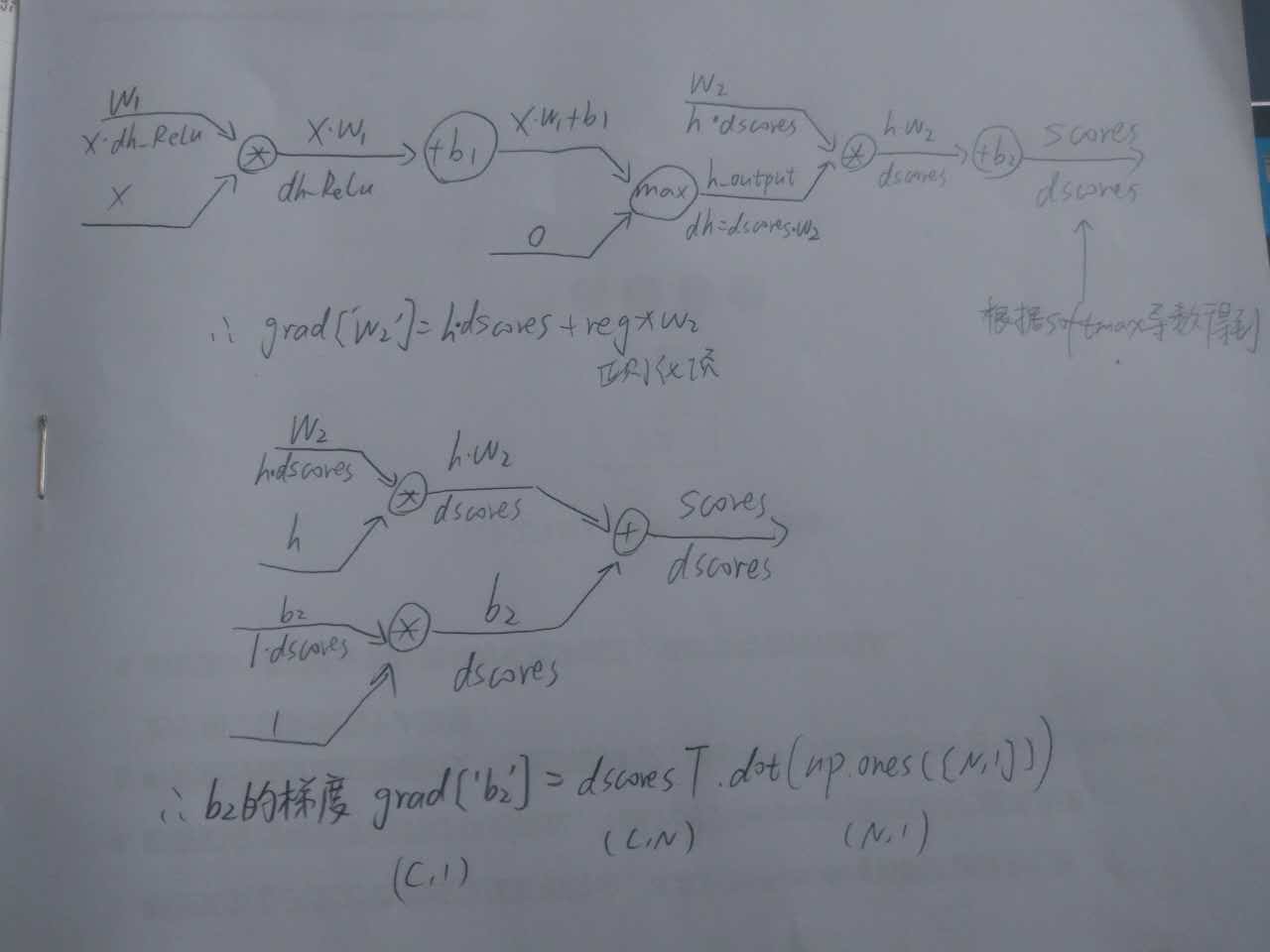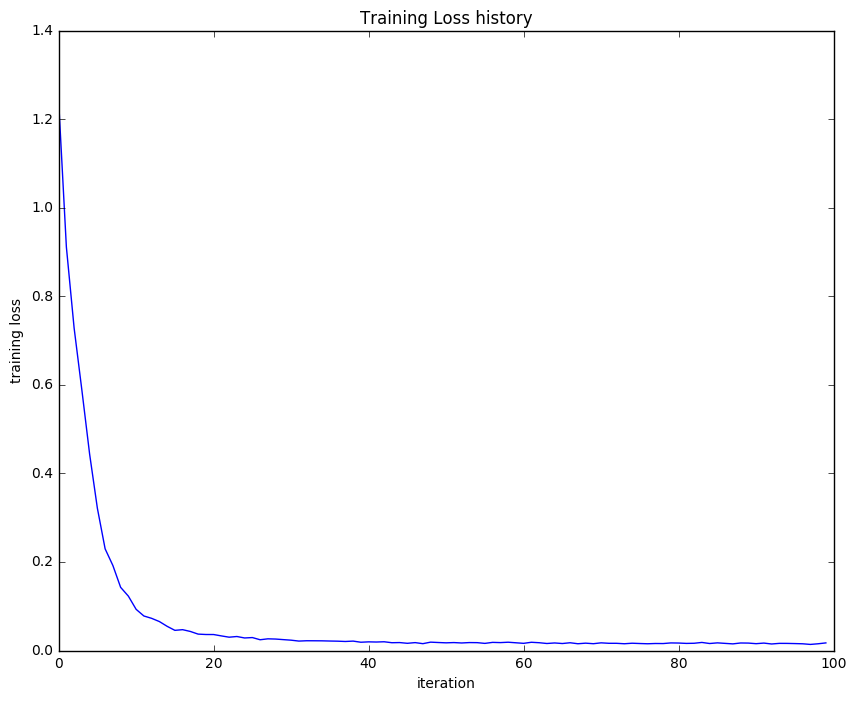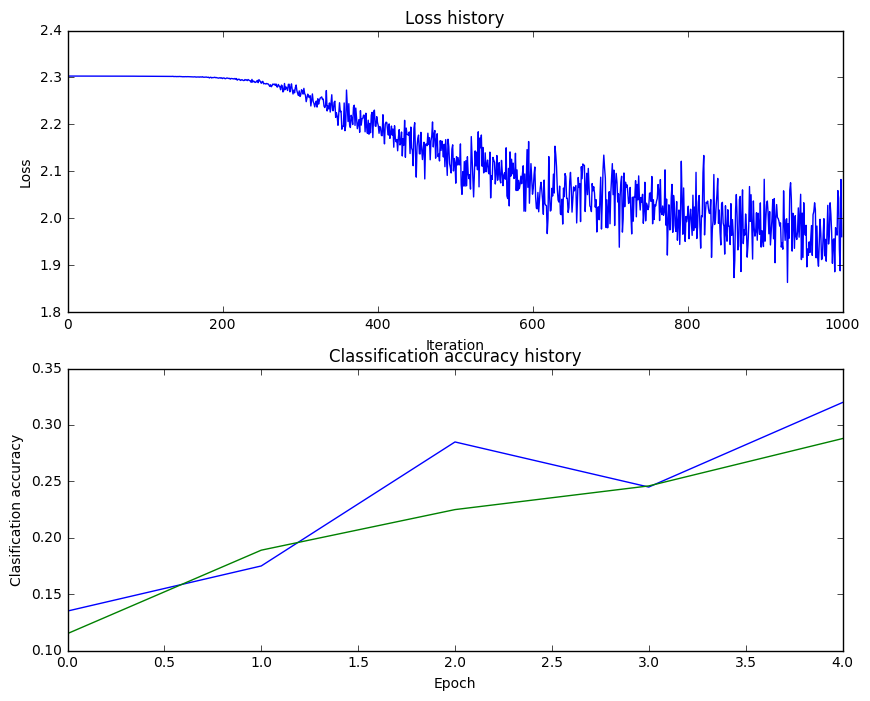cs231n的第一次作业2层神经网络
2017-02-19 11:05
351 查看
一个小测试,测试写的函数对不对
首先是初始化
input_size = 4 hidden_size = 10 num_classes = 3 num_inputs = 5 def init_toy_model(): np.random.seed(0) return TwoLayerNet(input_size, hidden_size, num_classes, std=1e-1) def init_toy_data(): np.random.seed(1) X = 10 * np.random.randn(num_inputs, input_size) y = np.array([0, 1, 2, 2, 1]) return X, y net = init_toy_model() X, y = init_toy_data() print X.shape, y.shape
初始化
class TwoLayerNet(object):
def __init__(self, input_size, hidden_size, output_size, std=1e-4):
"""
Initialize the model. Weights are initialized to small random values and
biases are initialized to zero. Weights and biases are stored in the
variable self.params, which is a dictionary with the following keys:
W1: First layer weights; has shape (D, H)
b1: First layer biases; has shape (H,)
W2: Second layer weights; has shape (H, C)
b2: Second layer biases; has shape (C,)
Inputs:
- input_size: The dimension D of the input data.
- hidden_size: The number of neurons H in the hidden layer.
- output_size: The number of classes C.
"""
self.params = {}
self.params['W1'] = std * np.random.randn(input_size, hidden_size)
self.params['b1'] = np.zeros(hidden_size)
self.params['W2'] = std * np.random.randn(hidden_size, output_size)
self.params['b2'] = np.zeros(output_size)对于W1的维数,即将输入样本的个数每个分配一个权重,最后输出相当于是hidden_size个分数,然后这些分数和激活函数相比较,b1应该是比较的阈值吧(自己觉得),有些分数就不会起作用。这样得
4000
到处理后的分数,在与W2相乘,与激活函数相比较,可以看到,W2输出是output_size,也就是说,输出的分数和类别数一样,即最终的分数。这里初始化这四个参数的意思大概就是这样子。
X的大小X.shape = (5, 4)
y的大小y.shape = (5, )
net.params[‘W1’].shape = (4, 10)
net.params[‘b1’].shape = (10, )
net.params[‘W2’].shape = (10, 3)
net.params[‘b2’].shape = (3, )
知道了维数关系,也就清楚了是 X*W 而不是 W*X,这个按实际去写,不要硬记。
计算loss和grad
def loss(self, X, y=None, reg=0.0):
"""
Compute the loss and gradients for a two layer fully connected neural network.
Inputs:
- X: Input data of shape (N, D). Each X[i] is a training sample.
- y: Vector of training labels. y[i] is the label for X[i], and each y[i] is
an integer in the range 0 <= y[i] < C. This parameter is optional; if it
is not passed then we only return scores, and if it is passed then we
instead return the loss and gradients.
- reg: Regularization strength.
Returns:
If y is None, return a matrix scores of shape (N, C) where scores[i, c] is
the score for class c on input X[i].
If y is not None, instead return a tuple of:
- loss: Loss (data loss and regularization loss) for this batch of training
samples.
- grads: Dictionary mapping parameter names to gradients of those parameters
with respect to the loss function; has the same keys as self.params.
"""
# Unpack variables from the params dictionary
W1, b1 = self.params['W1'], self.params['b1']
W2, b2 = self.params['W2'], self.params['b2']
N, D = X.shape
# Compute the forward pass
scores = None
# Perform the forward pass, computing the class scores for the input.
# score.shape (N, C).
h_output = np.maximum(0, X.dot(W1) + b1) # (N,D) * (D,H) = (N,H)
scores = h_output.dot(W2) + b2
# If the targets are not given then jump out, we're done
if y is None:
return scores
# Compute the loss
loss = None
#Finish the forward pass, and compute the loss.
shift_scores = scores - np.max(scores, axis=1).reshape(-1, 1)
softmax_output = np.exp(shift_scores) / np.sum(np.exp(shift_scores), axis=1).reshape(-1, 1)
loss = -np.sum(np.log(softmax_output[range(N), list(y)]))
loss /= N
loss += 0.5 * reg * (np.sum(W1 * W1) + np.sum(W2 * W2))
# Backward pass: compute gradients
grads = {}
# Compute the backward pass, computing the derivatives of the weights #
# and biases. Store the results in the grads dictionary. For example, #
# grads['W1'] should store the gradient on W1, and be a matrix of same size #
dscores = softmax_output.copy()
dscores[range(N), list(y)] -= 1
dscores /= N
grads['W2'] = h_output.T.dot(dscores) + reg * W2
grads['b2'] = np.sum(dscores, axis=0)
dh = dscores.dot(W2.T)
dh_ReLu = (h_output > 0) * dh
grads['W1'] = X.T.dot(dh_ReLu) + reg * W1
grads['b1'] = np.sum(dh_ReLu, axis=0)
return loss, grads得分scores的计算,由之前权重W和输入X的shape可知,
h_output = np.maximum(0, X.dot(W1) + b1) #第一层网络,激活函数为max().
scores = h_output.dot(W2) + b2 #第二层网络,最后得到每个样本的分数
损失loss的计算,这里用的是softmax的损失函数,所以,要先减去最大值,归一化,达到数值稳定。最后取了平均并且加了1/2的正则化项。
shift_scores = scores - np.max(scores, axis=1).reshape(-1, 1) #为了数值稳定
softmax_output = np.exp(shift_scores) / np.sum(np.exp(shift_scores), axis=1).reshape(-1, 1)#算了所有的 分数/sum
loss = -np.sum(np.log(softmax_output[range(N), list(y)])) #损失是正确的分类的分数/sum
loss /= N #compute average
loss += 0.5 * reg * (np.sum(W1 * W1) + np.sum(W2 * W2))#加正则项,这些可以参考之前的softmax
对于梯度的计算,对分类正确的Wyi分类器求导要多一个-Xi(具体求导可以参考上篇softmax博客),所以这是下面第三行-1的原因。但是为什么没有乘以X呢(⊙o⊙)?,求解答
反向传播计算线路参考图

具体对应的代码
grads = {}
dscores = softmax_output.copy()
dscores[range(N), list(y)] -= 1
dscores /= N
grads['W2'] = h_output.T.dot(dscores) + reg * W2
grads['b2'] = np.sum(dscores, axis=0)
dh = dscores.dot(W2.T)
dh_ReLu = (h_output > 0) * dh
grads['W1'] = X.T.dot(dh_ReLu) + reg * W1
grads['b1'] = np.sum(dh_ReLu, axis=0)最后的测试结果,和提供的正确数据几乎一致
W1 max relative error: 3.561318e-09
W2 max relative error: 3.440708e-09
b2 max relative error: 4.447625e-11
b1 max relative error: 2.738421e-09
训练
def train(self, X, y, X_val, y_val,
learning_rate=1e-3, learning_rate_decay=0.95,
reg=1e-5, num_iters=100,
batch_size=200, verbose=False):
"""
Train this neural network using stochastic gradient descent.
Inputs:
- X: A numpy array of shape (N, D) giving training data.
- y: A numpy array f shape (N,) giving training labels; y[i] = c means that
X[i] has label c, where 0 <= c < C.
- X_val: A numpy array of shape (N_val, D) giving validation data.
- y_val: A numpy array of shape (N_val,) giving validation labels.
- learning_rate: Scalar giving learning rate for optimization.
- learning_rate_decay: Scalar giving factor used to decay the learning rate
after each epoch.
- reg: Scalar giving regularization strength.
- num_iters: Number of steps to take when optimizing.
- batch_size: Number of training examples to use per step.
- verbose: boolean; if true print progress during optimization.
"""
num_train = X.shape[0]
iterations_per_epoch = max(num_train / batch_size, 1)
# Use SGD to optimize the parameters in self.model
loss_history = []
train_acc_history = []
val_acc_history = []
for it in xrange(num_iters):
X_batch = None
y_batch = None
# Create a random minibatch of training data and labels, storing #
# them in X_batch and y_batch respectively. #
idx = np.random.choice(num_train, batch_size, replace=True)
X_batch = X[idx]
y_batch = y[idx]
# Compute loss and gradients using the current minibatch
loss, grads = self.loss(X_batch, y=y_batch, reg=reg)
loss_history.append(loss)
# Use the gradients in the grads dictionary to update the #
# parameters of the network (stored in the dictionary self.params) #
# using stochastic gradient descent. You'll need to use the gradients #
# stored in the grads dictionary defined above. #
self.params['W2'] += - learning_rate * grads['W2']
self.params['b2'] += - learning_rate * grads['b2']
self.params['W1'] += - learning_rate * grads['W1']
self.params['b1'] += - learning_rate * grads['b1']
if verbose and it % 100 == 0:
print 'iteration %d / %d: loss %f' % (it, num_iters, loss)
# Every epoch, check train and val accuracy and decay learning rate.
if it % iterations_per_epoch == 0:
# Check accuracy
train_acc = (self.predict(X_batch) == y_batch).mean()
val_acc = (self.predict(X_val) == y_val).mean()
train_acc_history.append(train_acc)
val_acc_history.append(val_acc)
# Decay learning rate
learning_rate *= learning_rate_decay
return {
'loss_history': loss_history,
'train_acc_history': train_acc_history,
'val_acc_history': val_acc_history,
}训练基本和之前的softmax和svm一样,取小样本,计算损失和梯度,用SGD更新W和b(在svm中,W增加了一列,放b)。
最后的几句代码,计算了预测准确率,并且学习率在不停的减小。
画出loss_history与迭代次数的曲线,可以看到20次后loss基本不变。

开始用CIFAR10数据实战
测试小例子很成功呀,是时候开始用CIFAR10数据来实验。input_size = 32 * 32 * 3 hidden_size = 50 num_classes = 10 net = TwoLayerNet(input_size, hidden_size, num_classes) # Train the network stats = net.train(X_train, y_train, X_val, y_val, num_iters=1000, batch_size=200, learning_rate=1e-4, learning_rate_decay=0.95, reg=0.5, verbose=True) # Predict on the validation set val_acc = (net.predict(X_val) == y_val).mean() print 'Validation accuracy: ', val_acc
输出结果
iteration 0 / 1000: loss 2.302954
iteration 100 / 1000: loss 2.302550
iteration 200 / 1000: loss 2.297648
iteration 300 / 1000: loss 2.259602
iteration 400 / 1000: loss 2.204170
iteration 500 / 1000: loss 2.118565
iteration 600 / 1000: loss 2.051535
iteration 700 / 1000: loss 1.988466
iteration 800 / 1000: loss 2.006591
iteration 900 / 1000: loss 1.951473
Validation accuracy: 0.287
训练集的准确率只有28.7%,不太理想呀

蓝线为 train_acc_history,绿线为 val_acc_history
hidden_size = [75, 100, 12
a1d8
5]
learning_rates = np.array([0.7, 0.8, 0.9, 1, 1.1])*1e-3
regularization_strengths = [0.75, 1, 1.25]
hs 100 lr 1.100000e-03 reg 7.500000e-01 val accuracy: 0.502000
best validation accuracy achieved during cross-validation: 0.502000
用了三层for循环,硬生生找了三个较好的参数,准确率达到了50.2%
hint里提示用PCA降维,adding dropout, 或者adding features to the solver来到达更好的效果,这些先放着以后试吧(加粗防忘记)
参考
(对了如果想保存网页内容,可以用chrome浏览器,右键打印,保存为pdf,可以选择保存的页数,再打印出来看,对着电脑看眼睛吃不消了)知乎翻译https://zhuanlan.zhihu.com/p/21407711?refer=intelligentunit
建议看看课件和视频https://www.youtube.com/watch?v=GZTvxoSHZIo&t=3093s
相关文章推荐
- CS231n作业笔记2.2:多层神经网络的实现
- CS231n作业笔记2.1:两层全连接神经网络的分层实现
- cs231n课程作业1——二层神经网络分类器感悟
- CS231n作业笔记1.6:神经网络的误差与梯度计算
- CS231n 学习笔记(3)——神经网络 part3 :最优化
- CS231n 学习笔记(4)——神经网络 part4 :BP算法与链式法则
- Coursera机器学习 week5 神经网络的学习 编程作业代码
- Coursera机器学习 week4 神经网络的表示 编程作业代码
- 数据挖掘 作业1 神经网络
- stanford coursera 机器学习编程作业 exercise4--使用BP算法训练神经网络以识别阿拉伯数字(0-9)
- CS231n 学习笔记(2)——神经网络 part2 :Softmax classifier
- cs231n-(5)神经网络-1:建立架构
- CS231n课程笔记4.2:神经网络结构
- 上机课作业:计算机网络与实务 第一次
- cs231n-(5)神经网络-2:设置数据和Loss
- cs231n-(5)神经网络-3:学习和评估
- cs231n 学习笔记(5)——神经网络part1:建立神经网络架构
- ufldl学习笔记与编程作业:Multi-Layer Neural Network(多层神经网络+识别手写体编程)
- 第一次作业:网络数据截获
- CS231n 卷积神经网络与计算机视觉 7 神经网络训练技巧汇总 梯度检验 参数更新 超参数优化 模型融合 等
